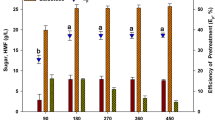Abstract
This study employed a statistical method to obtain optimal hyper thermal acid hydrolysis conditions using Gelidium amansii (red seaweed) as a source of biomass. The optimal hyper thermal acid hydrolysis using G. amansii as biomass was determined as 12% (w/v) slurry content, 358.3 mM H2SO4, and temperature of 142.6 °C for 11 min. After hyper thermal acid hydrolysis, enzymatic saccharification was carried out. The total monosaccharide concentration was 45.1 g/L, 72.2% of the theoretical value of the total fermentable monosaccharides of 62.4 g/L based on 120 g dry weight/L in the G. amansii slurry. To increase ethanol production, 3.8 g/L 5-hydroxymethylfurfural (HMF) in the hydrolysate was removed by treatment with 3.5% (w/v) activated carbon for 2 min and fermented with Pichia stipitis adapted to high galactose concentrations via separate hydrolysis and fermentation. With complete HMF removal and the use of P. stipitis adapted to high galactose concentrations, 22 g/L ethanol was produced (yield 0.50). Fermentation with total HMF removal and yeast adapted to high galactose concentrations increased the fermentation performance and decreased the fermentation time from 96 to 36 h compared to traditional fermentation.



Similar content being viewed by others
References
Tenenbaum DJ (2008) Food vs. fuel: diversion of crops could cause more hunger. Environ Health Perspect 116:A254–A257
Harun R, Yip JWS, Thiruvenkadam S, Ghani WAWAK., Cherrington T, Danquah MK (2014) Algal biomass conversion to bioethanol—a step-by-step assessment. Biotechnol J 9:73–86
Yanagisawa M, Kawai S, Murata K (2013) Strategies for the production of high concentrations of bioethanol from seaweeds: production of high concentrations of bioethanol from seaweeds. Bioengineered 4:224–235
Yoon JJ, Kim YJ, Kim SH, Ryu HJ, Choi JY, Kim GS, Shin MK (2010) Production of polysaccharides and corresponding sugars from red seaweed. Adv Mater Res 93–94:463–466
Cho H, Ra CH, Kim S-K (2014) Ethanol production from the seaweed Gelidium amansii, using specific sugar acclimated yeasts. J Microbiol Biotechnol 24:264–269
Lenihan P, Orozco A, O’Neill E, Ahmad MNM, Rooney DW, Walker GM (2010) Dilute acid hydrolysis of lignocellulosic biomass. Chem Eng J 156:395–403
Meinita MDN, Hong Y-K, Jeong G-T (2012) Detoxification of acidic catalyzed hydrolysate of Kappaphycus alvarezii (cottonii). Bioprocess Biosyst Eng 35:93–98
Saha BC, Iten LB, Cotta MA, Wu YV (2005) Dilute acid pretreatment, enzymatic saccharification and fermentation of wheat straw to ethanol. Process Biochem 40:3693–3700
Ra CH, Nguyen TH, Jeong G-T, Kim S-K (2016) Evaluation of hyper thermal acid hydrolysis of Kappaphycus alvarezii for enhanced bioethanol production. Bioresour Technol 209:66–72
Jeong G-T, Ra CH, Hong Y-K, Kim JK, Kong I-S, Kim S-K, Park D-H (2015) Conversion of red-algae Gracilaria verrucosa to sugars, levulinic acid and 5-hydroxymethylfurfural. Bioprocess Biosyst Eng 38:207–217
Liu ZL, Ma M, Song M (2009) Evolutionarily engineered ethanologenic yeast detoxifies lignocellulosic biomass conversion inhibitors by reprogrammed pathways. Mol Genet Genom 282:233–244
Escalante-Chong R, Savir Y, Carroll SM, Ingraham JB, Wang J, Marx CJ, Springer M (2015) Galactose metabolic genes in yeast respond to a ratio of galactose and glucose. Proc Natl Acad Sci 112:1636–1641
Yoo CG, Lee CW, Kim TH (2011) Optimization of two-stage fractionation process for lignocellulosic biomass using response surface methodology (RSM). Biomass Bioenergy 35:4901–4909
Kim HJ, Ra CH, Kim S-K (2013) Ethanol production from seaweed (Undaria pinnatifida) using yeast acclimated to specific sugars. Biotechnol Bioprocess Eng 18:533–537
Kubicek CP (1982) beta-Glucosidase excretion by Trichoderma pseudokoningii: correlation with cell wall bound beta-1.3-glucanase activities. Arch Microbiol 132:349–354
Mandels M, Andreotti R, Roche C (1976) Measurement of saccharifying cellulase. Biotechnol Bioeng Symp 21–33
Jol CN, Neiss TG, Penninkhof B, Rudolph B, De Ruiter GA (1999) A novel high-performance anion-exchange chromatographic method for the analysis of carrageenans and agars containing 3,6-anhydrogalactose. Anal Biochem 268:213–222
Jeong TS, Kim YS, Oh KK (2011) Two-stage acid saccharification of fractionated Gelidium amansii minimizing the sugar decomposition. Bioresour Technol 102:10529–10534
Jeong G-T, Park D-H (2010) Production of sugars and levulinic acid from marine biomass Gelidium amansii. Appl Biochem Biotechnol 161:41–52
Rodrigues AC, Haven M, Lindedam J, Felby C, Gama M (2015) Celluclast and Cellic® CTec2: saccharification/fermentation of wheat straw, solid–liquid partition and potential of enzyme recycling by alkaline washing. Enzyme Microb Technol 79–80:70–77
Kim N-J, Li H, Jung K, Chang HN, Lee PC (2011) Ethanol production from marine algal hydrolysates using Escherichia coli KO11. Bioresour Technol 102:7466–7469
Zhao X, Moates GK, Elliston A, Wilson DR, Coleman MJ, Waldron KW (2015) Simultaneous saccharification and fermentation of steam exploded duckweed: improvement of the ethanol yield by increasing yeast titre. Bioresour Technol 194:263–269
Guo Z, Olsson L (2014) Physiological response of Saccharomyces cerevisiae to weak acids present in lignocellulosic hydrolysate. FEMS Yeast Res 14:1234–1248
Gütsch JS, Sixta H (2011) The HiTAC-process (high temperature adsorption on activated charcoal)—new possibilities in autohydrolysate treatment. Lenzing Ber 89:142–151
Ra CH, Jung JH, Sunwoo IY, Kang CH, Jeong GT, Kim S-K (2015) Detoxification of Eucheuma spinosum hydrolysates with activated carbon for ethanol production by the salt-tolerant yeast Candida tropicalis. J Microbiol Biotechnol 25:856–862
Ra CH, Jeong G-T, Shin MK, Kim S-K (2013) Biotransformation of 5-hydroxymethylfurfural (HMF) by Scheffersomyces stipitis during ethanol fermentation of hydrolysate of the seaweed Gelidium amansii. Bioresour Technol 140:421–425
Nguyen TH, Ra CH, Sunwoo IY, Jeong GT, Kim S-K (2016) Evaluation of galactose adapted yeasts for bioethanol fermentation from Kappaphycus alvarezii hydrolyzates. J Microbiol Biotechnol 26:1259–1266
Acknowledgements
This research was supported by Basic Science Research Program through the National Research Foundation of Korea (NRF), funded by the Ministry of Education (2016R1D1A1A09918683), Korea.
Author information
Authors and Affiliations
Corresponding author
Rights and permissions
About this article
Cite this article
Sukwong, P., Ra, C.H., Sunwoo, I.Y. et al. Improved fermentation performance to produce bioethanol from Gelidium amansii using Pichia stipitis adapted to galactose. Bioprocess Biosyst Eng 41, 953–960 (2018). https://doi.org/10.1007/s00449-018-1926-z
Received:
Accepted:
Published:
Issue Date:
DOI: https://doi.org/10.1007/s00449-018-1926-z




